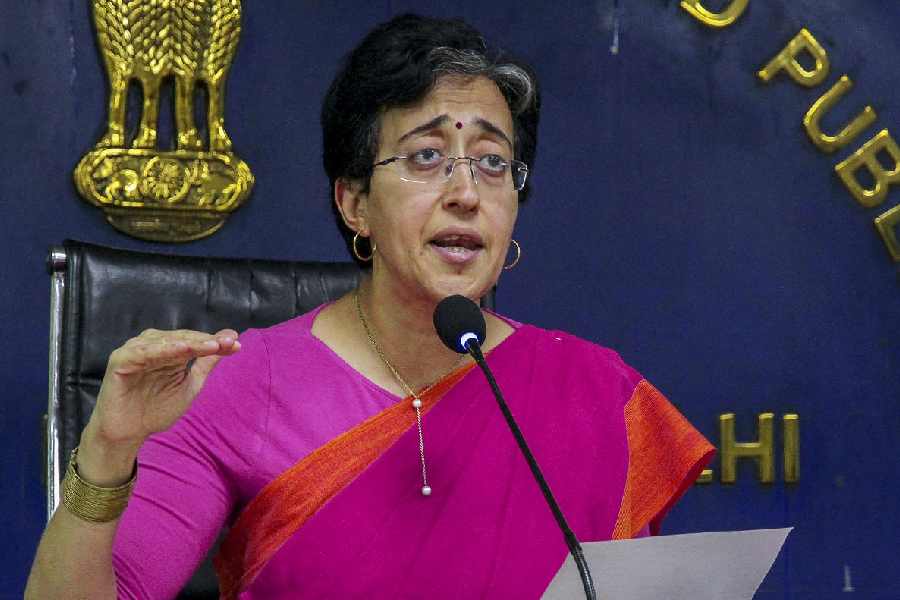Pollution triggered by immersion of idols in the Hooghly since Dashami have led environmentalists to point to the lack of infrastructure at ghats on both sides of the river.
The environmentalists have questioned the rationale behind immersing maximum number of idols at ghats with inadequate facilities.
Of all ghats in Calcutta and Howrah, environmentalists feel Gwalior ghat is least suitable for immersion for poor infrastructure. However, since Dashami, most immersions took place at Gwalior ghat, while fewer idols were immersed at Nimtala, which has comparatively better facilities. Environmentalists say this contributed to greater pollution of the river.
As idols float in the river, heavy metals used in making cheap colour — such as lead and chromium — are released into the water, polluting it significantly. Green activists say even when the water is treated and made potable, the heavy metals cannot be segregated.
Apart from clay, which is non-pollutant, several idols are made using plaster of Paris. When plaster of Paris mixes with water, the river’s eco-system gets disturbed.
“Till Thursday, there have been around 3,100 immersions. Of these, 1,000 idols were immersed at Gwalior ghat, which is also known as Judges ghat. Baje Kadamtala ghat witnessed nearly 900 immersions, while 400-odd idols were immersed at Nimtala ghat,” said an official of the Calcutta Municipal Corporation.
“Idols should not be immersed at Gwalior ghat as it is a complete misfit for the purpose. Immersing idols there means polluting the river significantly,” said green activist Subhas Datta.
The civic body is aware of the problem. “It’s a mindset issue. Clubs do not want to change the ghat where it usually immerses the idols. It is a known fact that Gwalior ghat is not suitable for immersions, but still many clubs prefer to immerse idols there instead of Baje Kadamtala ghat, which is just 200 metres away and has much better facilities,” said Debasish Kumar, CMC’s mayor-in-council member and in-charge of immersions.
Metro visited all the major ghats on both sides of the river till midnight on Thursday and saw how “good” and “bad” immersions were taking place. Efforts to contain pollution was visible at Baje Kadamtala and Nimtala ghats, while there was no such initiative at other places.
Recently, the National Mission for Clean Ganga (NMCG), formed following verdicts of the National Green Tribunal and courts, had directed states, including Bengal, not to immerse idols in the Ganges or its tributaries. The order was passed as part of an effort to stop river pollution. However, the order came too late to be implemented in Bengal this year.
“We will present before the National Green Tribunal the efforts we took to minimise river pollution during immersions this year,” said a senior CMC official, who apprehended a hefty fine for not implementing the NMCG directive. Metro gives a low-down of the state of the ghats during immersions.
Baje Kadamtala ghat
The best ghat in terms of infrastructure witnessed about 900 immersions in the first three days. Three cranes, along with one fitted to a barge, lifted idols immediately after they were immersed to minimise river pollution. Trucks were at hand to remove debris from the ghat. Nearly 200 officials from police, CMC and the disaster management team helped in the immersion process. About 75 civic workers kept removing the idols from water.
Nimtala ghat
The ghat is well-equipped for immersions. Its wide ramp helped immerse idols, while cranes, both on land and one mounted on a barge, worked continuously since Dashami to minimise river pollution. Only 400 idols had been immersed here since Dashami. Nearly, 75 civic workers and volunteers helped ensure a less polluted river.
Gwalior ghat
Though the worst in terms of infrastructure, maximum number of idols were immersed here. As it lacks a ramp, porters used the divider of the staircase leading to the river to immerse idols. This left many idols damaged and posed a risk to onlookers. In the absence of cranes, volunteers and CMC personnel used ropes to stop idols from drifting away in the river. Metro saw many idols floating in the river.
Ramkrishnapur ghat
Among the ghats in Howrah, this one witnessed the maximum number of immersions. Nearly 500 idols were immersed here. Though it has a ramp, there were no cranes or trucks to lift and take away the idols post-immersion. A few volunteers dragged the immersed idols and tied them to the jetty. This seemed the most polluted ghat on either bank.
Other ghats
At other 14 ghats in Calcutta and Howrah, the process to drag out the structures was quite slow. The delay contributed significantly in polluting the river.










